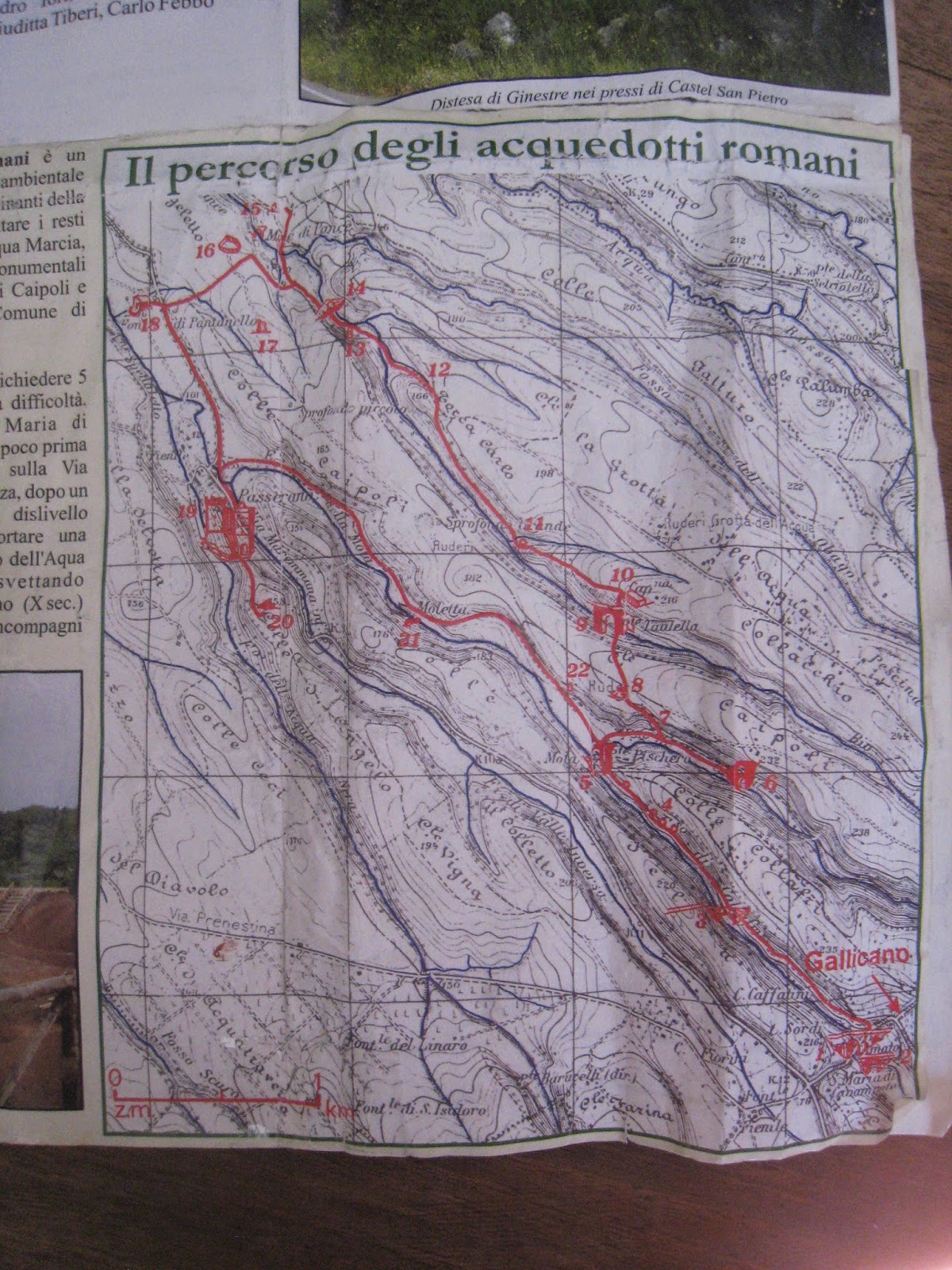 |
First step in the aqueduct hunt: waiting for the bus to get around the corner of
the tagliata [the "cut" in the tufo] - a car driver finally got out and directed traffic. |
Aqueducts are the imposing reminders of Rome's thousands of years of history, and we're as intrigued as anyone by them. So when we saw a map that purported to show "The Roman aqueducts itinerary," we were ready to go. We assumed we'd be tromping through weeds that grow up among the high aqueducts, as one does at the
Parco degli acquedotti [Aqueduct Park], not far from the center of Rome.
 |
Yes, we thought this map would get us there.
Oh, well. |
We were a bit perplexed when we did not see any of these high aqueducts, as one often does, as we scootered ten, then twenty and more kilometers out of Rome on the via Prenestina, the road that led ancient Romans to Palestrina, almost to the current town of Gallicano nel Lazio. We dutifully followed the guide that told us we would go through and out of the darkness of something called the "
Tagliata [cut]
di Santa Maria di Cavamonte." And a "cut" through the high
tufo rock it was, as we waited for a bus, stuck in trying to make a curve through the dark
tagliata [a word that until then meant for us a nice cut of steak].
 |
The first or second century AD bridge on the ancient Roman road
to Palestrina - Ponte Amata. Not an aqueduct, but our starting point. |
Beyond the
Tagliata we found our starting point,
Ponte Amata, a first or second century A.D. bridge over the
fosso [deep gully] in pristine condition, restored after being damaged in World War II, but now beginning to be surrounded again by the high grasses and weeds. The
ponte's dating is not certain, but is based on the
Ponte di Nona, not too far away also on the ancient via Prenestina [at its ninth Roman mile from Rome] -
and about which we've also written on the blog.
 |
| Dianne on the ancient via Prenestina, just before Ponte Amata. |
Ponte Amata is just off the road, having been on the original via Prenestina, and it wasn't far along the road that we found good signposts indicating our route - or something close to it.
We trudged down a road, that became increasingly
sterrata - or unpaved, until we came to another signpost - indicating our aqueduct was - to our surprise - far below where we were walking.
 |
Our first aqueduct siting: Ponte della Bullica. Dianne's red jacket
is visible where she's standing on the aqueduct bridge, about 50 feet above the
bottom of the fosso. |
We followed the path down [down, down down] to another bridge over the
fosso, and it was an aqueduct from the first or second century AD crossing the
fosso. This one bears the name of
Ponte della Bullica and carries the Aqua Marcia water, second century AD. Pretty exciting stuff for us. Yes, we had found our aqueduct - not high above the
campagna, or fields outside Rome, but deep in the gullies.
There are four aqueducts that cross through the valleys or gullies in this fairly compact area around the via Prenestina here, including Anio Vetus, Aqua Marcia, Anio Novus and Aqua Claudio, several on top of each other through the same structure. That's a fine collection of aqueducts for any aqueduct hunter.
 |
Amazing Roman engineering: Ponte Pischero, that carried the aqueduct
Anio Vetus. |
 |
| We nixed the spelunking. |
We found another aqueduct bridge, complete with caves that apparently one can explore - we chose not to:
Ponte Pischero, billed as carrying the Anio Vetus water in 270 AD.
And then our guideposts mysteriously disappeared. After more than an hour of traipsing around, through, and back and forth through farmers' fields, we were ready to give up.
 |
| Trail lost. |
 |
| But views were great. |
We found ourselves on a road that wasn't on our map. [Most of the hiking maps are laid over World War II maps], with cars whizzing by.
 |
| Wait...this road isn't on the map. |
Miraculously, it seemed, we saw a sign for via Francigena, one of the many St. Francis paths that cross central Italy. We took a chance that it might follow the aqueduct route and scouted it out across the road.
 |
| The hazards of aqueduct hunting: a possible path through a dump. |
We traced it through a dump, literally, and, lo and behold, we found yet another gorgeous aqueduct bridge. We marked this one on our Google map, in the hopes that some of you can find it too.
https://maps.google.com/?q=41.886067,12.796168&hl=en&gl=us We've also included below links to some Italian sites on the area - not that they are very helpful in actually getting you to the aqueducts. And we've added a few more photos at the end.
 |
| Our last sighting: the aqueduct bridge, Taulella, carried Anio Vetus water. |
With that discovery we thought surely we were wise enough now to find a few other places marked on our original map, but another hour-plus of slogging through briers, weeds, cliffs, and paths yielded beautiful views but no aqueducts.
Perhaps we'll go back one day to see if we can locate the other sites on the map. But maybe not. We think we've earned our aqueduct hunter badge by now, and may let it rest.
Dianne
Links that might be helpful:
http://www.tesorintornoroma.it/Itinerari/La-Via-Prenestina/Gallicano-nel-Lazio-Itinerario-degli-acquedotti-romani-e-ponte-Amato
http://www.tibursuperbum.it/ita/escursioni/gallicano/ponteamato.htm
 |
What the top of an aqueduct bridge looks like today;
complete with rope so you don't fall over. |
 |
| More examples of great Roman engineering; still with us. |


